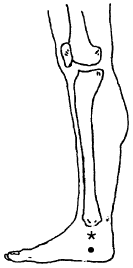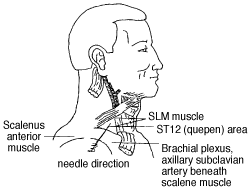Whether it is a sequel to AIDS, diabetes, cancer therapies or alcoholism, or some form of hereditary, toxic, metabolic, infectious, inflammatory or ischemic disease, peripheral neuropathy (polyneuritis) is an insidious condition that causes much suffering to millions of patients.
All of the aforementioned diseases have in common a severe deficiency of yin, blood and qi such that static blood is engendered. Since the etiology of most of this blood stagnation is qi, blood or yin deficiency, for long lasting results, these causative factors must be addressed, along with the treatment strategy to invigorate the blood. Regardless of whether one uses acupuncture or an herbal prescription, the correct treatment entails addressing the factors involved.
From an acupuncture perspective, certain unique therapies, particularly those involving blood stasis, can benefit the treatment of this condition. Acupuncture points with known clinical efficacy can then be added to the core treatment to address underlying deficiencies.
Traditional acupuncture treatment approaches have concentrated on local points, the luo and shu (stream) points of the affected meridians. In my treatment of peripheral neuropathy of the lower limbs, I use five core points: KI1 (yongquan), LR4 (zhongfeng), SP6 (sanyinjiao), GB34 (yanglingquan) and KI6 (zhaohai). For the upper extremities, I rely on PC6 (neiguan), LU9 (taiyuan), LI11 (quchu), ST12 (quepen) and CV17 (tanzhong). To determine their applicability in treatment, palpate each point, one at a time, for any noticeable tenderness the patient may report to you. Press the point in a rubbing motion for about three seconds to the depth you would actually needle to. If the point is tender, it can be needled in treatment. For reader convenience, the energetics of these points, as well as their corresponding needling techniques and locations (some of which are different), are summarized in Table 1.
| Table 1: Primary treatment points for peripheral neuropathy of the lower and upper limbs. Overall treatment: 1. To promote blood circulation and blood stasis; 2. To supplement the qi, blood and yin. | ||
| LOWER LIMB | ||
| Point | Energetics | Needle Technique |
| KI1 (youngquan) |
| Puncture perpendicularly .3-.5 in. with a #1 gauge needle. Patients should be taught to press the point on a daily basis for several minutes. Continue daily until there is no more tenderness. Can also be plum blossomed. |
| LR4 (zhongfeng) |
| Puncture perpendicularly .3-.5 in. or obliquely upward in the direction of the liver meridian. Can be rubbed firmly by patient for self-treatment. |
| SP6 (sanyinjiao) |
| Puncture perpendicularly .5-1.0 inches. |
| KI6 (zhaohai) Alternate location, see Figure 1 |
| Puncture transversely .1 in. towards the heel with a #1 gauge needle. Obtain no qi. |
| GB34 (yanglingquan) Alternate location, see Figure 2 |
| Puncture perpendicularly .8-1.2 in. Have the patient rub with strong pressure. |
| UPPER LIMB | ||
| PC6 (neiguan) |
| Puncture perpendicularly .5-1.0 in. or apply deep dispersive pressure by hand, especially on the left side. |
| LI11 (quchi) |
| Puncture perpendicularly .5-1.0 in. |
| ST12 (quepen)* see Figure 3 |
| Puncture perpendicularly .3-.5 in., avoiding the transverse cervical artery. Needle with caution, as this point is on the apex of the lung. Alternate technique is with patient lying on their side to puncture perpendicularly toward the spine. |
| LU9 (taiyuan) |
| Puncture perpendicularly .2-.3 in. |
| CV17 (tanzhong) |
| Puncture transversely upward (toward the head in the direction of the meridian) .3-.5 in. |
| Contraindications and Instructions |
| Retain needles 10-15 minutes. |
As part of self-treatment, the patient can also apply the Chinese liniment zheng gu shui to the affected areas. Zheng gu shui is the most powerful Chinese prepared liniment in the sense that it has the strongest ability to penetrate, thus allowing it to be the liniment of choice for moving blood stagnation. Apply the liniment generously before bed with a cotton ball and let dry, as the liquid will stain clothes. Do not apply it near open wounds, on irritated skin or ulcerated tissue, or near mucous membranes. Discontinue use if irritation or excessive dryness develops.

|

|
An additional effective treatment modality includes the use of a plum blossom needle at the areas where the neuropathy occurs. Lightly tap the skin surface starting distally, then move up the legs or arms in the direction of venous circulation and repeat. Do this for about three minutes. This hammering technique can be slightly discomforting to the patient, but it is an effective strategy that should be tolerated for its effects. Some slight blood extravasation in the form of small droplets may occur as a result of the tapping; this is both normal and therapeutic. You can give patients a plastic disposable plum blossom needle with which they can treat themselves on a daily basis to accelerate a curative effect. Instruct your patients on how to use and dispose of the tool properly, and notify them only to use it on him or herself to prevent the transmission of infectious disease.

The use of these 10 powerful points, augmented with an external liniment and ancillary techniques, constitutes an effective treatment protocol for the clinical manifestations of peripheral neuropathy and its underlying pathologies of blood stasis, qi, blood and yin deficiency, and can bring much relief to an anguished population.
Click here for previous articles by Skya Abbate, DOM.




